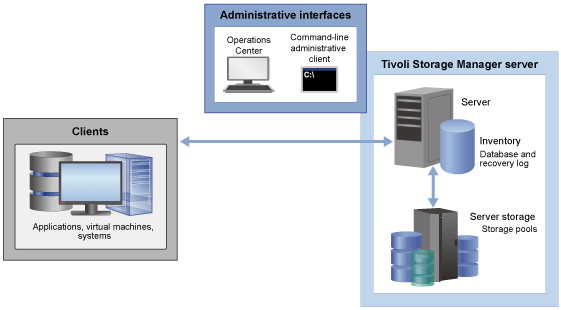IBM® Tivoli® Storage Manager provides centralized, automated data protection that can help reduce the risks that are associated with data loss and help manage compliance with data retention and availability requirements.

Server
The Tivoli Storage Manager server stores client data to storage media. The server includes an inventory in which Tivoli Storage Manager stores information about the client data that it is protecting.
- Database
- Tivoli Storage Manager saves information about each file, logical volume, or database that it backs up, archives, or migrates. This inventory data is stored in the server database. The server database also includes information about the policy and schedules for data protection services. Client data is stored in a storage pool.
- Recovery log
- The recovery log consists of the active and archive logs, and
other optional logs. These logs are records of database transactions,
which can be used for database recovery. If a failure occurs, such
as a power outage or application error, the changes that were made
but not committed are rolled back. Then, all committed transactions,
which might not yet be written to disk, are redone.
- Active log
- The active log is a record of the most recent database transactions that are not yet committed.
- Archive log
- The archive log is a record of the most recent database transactions that are committed but not yet included in a database backup.
Storage
The Tivoli Storage Manager server can write data to hard disk drives, disk arrays and subsystems, stand-alone tape drives, tape libraries, and other forms of random-access and sequential-access storage. The media that the server uses are grouped into storage pools.- Storage pools
- Storage pools are a central Tivoli Storage
Manager concept. Understanding them is
key to effectively managing your Tivoli Storage
Manager server environment.
Storage pools connect the Tivoli Storage
Manager policy hierarchy
to the storage devices where client data is stored. A storage pool
represents a set of volumes of the same media type, for example, disk
or tape volumes.
Tivoli Storage Manager stores all managed data objects in storage pools. You can organize storage pools into one or more hierarchical structures, and each storage hierarchy can span multiple Tivoli Storage Manager server instances.
To obtain the best value from your storage investment, you must store data appropriately in the storage pool hierarchy. A disk pool is often first in the hierarchy and can be followed by a tape pool. Tivoli Storage Manager supports many device and media types for sequential access storage.
Clients
Tivoli Storage Manager clients or client nodes protect data by sending it to a Tivoli Storage Manager server. Client software must be installed on the client system, and the client must be registered with the server.
A client node is usually equivalent to a computer, such as a backup-archive client that is installed on a workstation for file system backups. A file space is a group of client files that are stored as a logical unit in server storage.
Multiple nodes can be installed on a single computer, as in the case of a Microsoft SQL server that contains both an application client for SQL database backups and a backup-archive client for file system backups.
- Applications
- The following clients are application clients. Data that is being
protected for these clients is structured data that requires interaction
with backup interfaces specific to the application:
- Tivoli Storage Manager for Enterprise Resource Planning
- Tivoli Storage FlashCopy® Manager
- Tivoli Storage Manager for Databases
- Tivoli Storage Manager for Mail
- Tivoli Storage
Manager for Virtual Environments
This excludes VMware vSphere clients, which are classified as system clients.
- Virtual machines
- A virtual machine is an individual guest that is hosted within
a hypervisor. Each virtual machine is represented as a Tivoli Storage
Manager file space.
Backups for multiple virtual machines are consolidated together under
a common node. Each virtual machine is stored under a separate file
space for this common node.
A client is considered a virtual machine when it is protected by either Data Protection for VMware or Data Protection for Microsoft Hyper-V.
- Systems
- All other clients, for example, backup-archive and API clients,
are classified as system clients. These clients back up unstructured
data that is contained within files and directories.System clients also include the following items:
- A Tivoli Storage Manager source server in a server-to-server virtual volume configuration
- A virtual machine that is backed up using backup-archive client software that is installed on the virtual machine